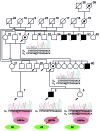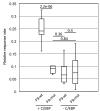Christmas disease in a Hovawart family resembling human hemophilia B Leyden is caused by a single nucleotide deletion in a highly conserved transcription factor binding site of the F9 gene promoter
- PMID: 30846504
- PMCID: PMC6821609
- DOI: 10.3324/haematol.2018.215426
Christmas disease in a Hovawart family resembling human hemophilia B Leyden is caused by a single nucleotide deletion in a highly conserved transcription factor binding site of the F9 gene promoter
Abstract
Hemophilia B is a classical monogenic, X-chromosomal, recessively transmitted bleeding disorder caused by genetic variants within the coagulation factor IX gene (F9). Although hemophilia B has been described in dogs, it has not yet been reported in the Hovawart breed. Here we describe the identification of a Hovawart family transmitting typical signs of an X-linked bleeding disorder. Five males were reported to suffer from recurrent hemorrhagic episodes. A blood sample from one of these males with only 2% of the normal concentration of plasma factor IX together with samples from seven relatives were provided. Next-generation sequencing of the mother and grandmother revealed a single nucleotide deletion in the F9 promoter. Genotyping of the deletion in 1,298 dog specimens including 720 Hovawarts revealed that the mutant allele was only present in the aforementioned Hovawart family. The deletion is located 73 bp upstream of the F9 start codon in the conserved overlapping DNA binding sites of hepatocyte nuclear factor 4α (HNF-4α) and androgen receptor (AR). The deletion only abolished binding of HNF-4α, while AR binding was unaffected as demonstrated by electrophoretic mobility shift assay using human HNF-4α and AR with double-stranded DNA probes encompassing the mutant promoter region. Luciferase reporter assays using wildtype and mutated promoter fragment constructs transfected into Hep G2 cells showed a significant reduction in expression from the mutant promoter. The data provide evidence that the deletion in the Hovawart family caused a rare type of hemophilia B resembling human hemophilia B Leyden.
Copyright© 2019 Ferrata Storti Foundation.
Figures



Similar articles
-
Hemophilia B Leyden: substitution of thymine for guanine at position -21 results in a disruption of a hepatocyte nuclear factor 4 binding site in the factor IX promoter.Blood. 1993 Jul 1;82(1):151-8. Blood. 1993. PMID: 8324220
-
Disruption of a binding site for hepatocyte nuclear factor 4 results in hemophilia B Leyden.Proc Natl Acad Sci U S A. 1992 Jul 15;89(14):6300-3. doi: 10.1073/pnas.89.14.6300. Proc Natl Acad Sci U S A. 1992. PMID: 1631121 Free PMC article.
-
Nucleotide substitutions at the -6 position in the promoter region of the factor IX gene result in different severity of hemophilia B Leyden: consequences for genetic counseling.Hum Genet. 1993 Apr;91(3):241-4. doi: 10.1007/BF00218264. Hum Genet. 1993. PMID: 8478007
-
Hemophilia B Leyden and once mysterious cis-regulatory mutations.Trends Genet. 2014 Jan;30(1):18-23. doi: 10.1016/j.tig.2013.09.007. Epub 2013 Oct 16. Trends Genet. 2014. PMID: 24138812 Review.
-
The Canadian "National Program for hemophilia mutation testing" database: a ten-year review.Am J Hematol. 2013 Dec;88(12):1030-4. doi: 10.1002/ajh.23557. Epub 2013 Sep 9. Am J Hematol. 2013. PMID: 23913812 Review.
Cited by
-
A Single Base Insertion in F9 Causing Hemophilia B in a Family of Newfoundland-Parti Standard Poodle Hybrid Dogs.Genes (Basel). 2021 Sep 24;12(10):1491. doi: 10.3390/genes12101491. Genes (Basel). 2021. PMID: 34680886 Free PMC article.
-
Detection of genomic structure variants associated with wrinkled skin in Xiang pig by next generation sequencing.Aging (Albany NY). 2021 Nov 27;13(22):24710-24739. doi: 10.18632/aging.203711. Epub 2021 Nov 27. Aging (Albany NY). 2021. PMID: 34837693 Free PMC article.
-
One Health: Animal Models of Heritable Human Bleeding Diseases.Animals (Basel). 2022 Dec 26;13(1):87. doi: 10.3390/ani13010087. Animals (Basel). 2022. PMID: 36611696 Free PMC article. Review.
-
Web resource on available DNA variant tests for hereditary diseases and genetic predispositions in dogs and cats: An Update.Hum Genet. 2021 Nov;140(11):1505-1515. doi: 10.1007/s00439-021-02256-5. Epub 2021 Feb 6. Hum Genet. 2021. PMID: 33547946
References
-
- Dolan G, Benson G, Duffy A, et al. Haemophilia B: where are we now and what does the future hold¿ Blood Rev. 2018;32(1):52–60. - PubMed
-
- Green P. The ‘royal disease’. J Thromb Haemost. 2010;8(10):2214–2215. - PubMed
-
- Rogaev EI, Grigorenko AP, Faskhutdinova G, Kittler EL, Moliaka YK. Genotype analysis identifies the cause of the “royal disease”. Science. 2009;326(5954):817. - PubMed
-
- Rallapalli PM, Kemball-Cook G, Tuddenham EG, Gomez K, Perkins SJ. An interactive mutation database for human coagulation factor IX provides novel insights into the phenotypes and genetics of hemophilia B. J Thromb Haemost. 2013;11(7): 1329–1340. - PubMed
-
- Mustard JF, Rowsell HC, Robinson GA, Hoeksema TD, Downie HG. Canine haemophilia B (Christmas disease). Br J Haematol. 1960;6:259–266. - PubMed
Publication types
MeSH terms
Substances
LinkOut - more resources
Full Text Sources
Research Materials
Miscellaneous

